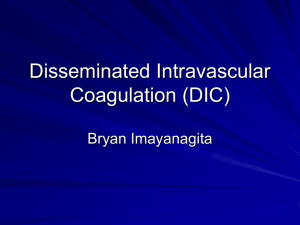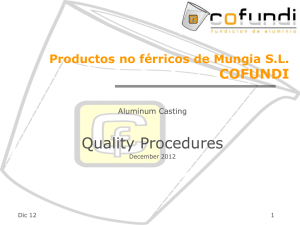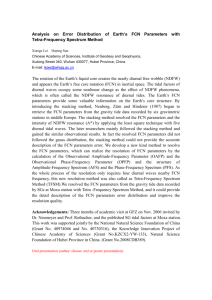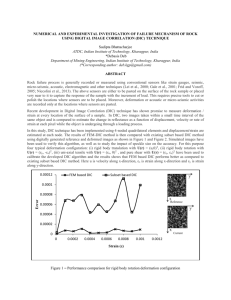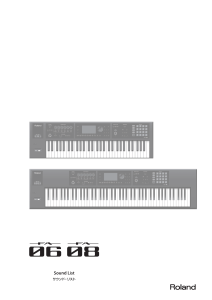Anaerobic biodegradation of the isoprenoid biomarkers pristane and
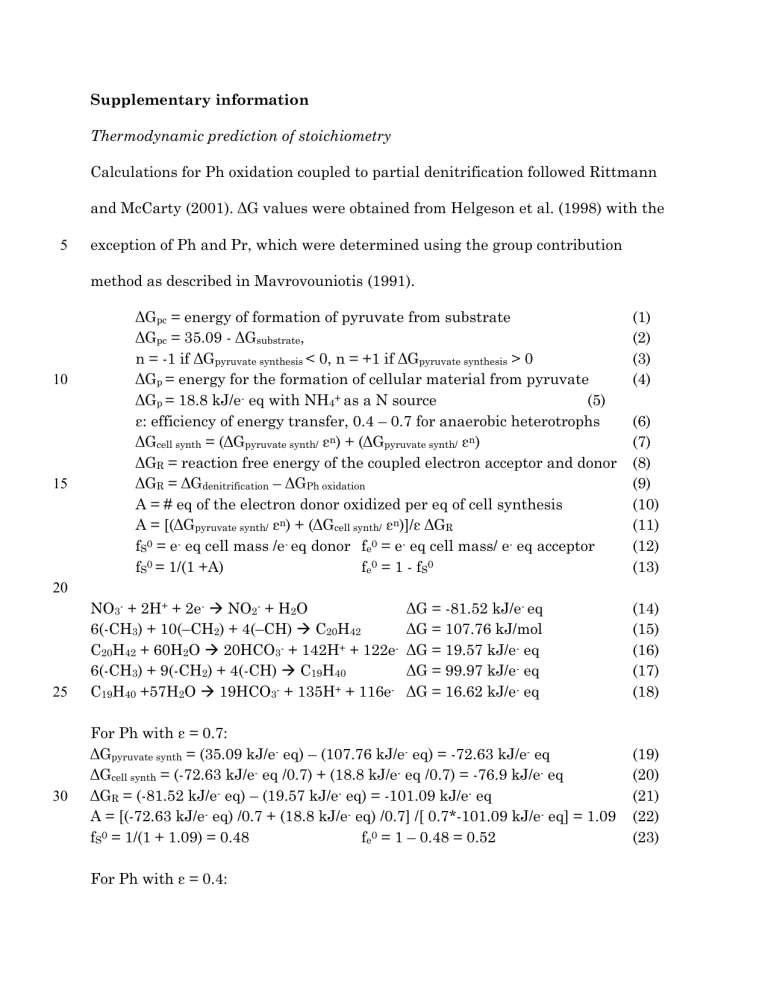
Supplementary information
Thermodynamic prediction of stoichiometry
5 exception of Ph and Pr, which were determined using the group contribution
method as described in Mavrovouniotis (1991).
10
15
20
25
30
ΔG pc
= energy of formation of pyruvate from substrate (1)
ΔG pc
= 35.09 - ΔG substrate
, n = -1 if ΔG pyruvate synthesis
< 0, n = +1 if ΔG pyruvate synthesis
> 0
(2)
(3)
ΔG p
= energy for the formation of cellular material from pyruvate
ΔG p
= 18.8 kJ/e eq with NH
4+ as a N source (5)
(4)
ε: efficiency of energy transfer, 0.4 – 0.7 for anaerobic heterotrophs (6)
ΔG cell synth
= (ΔG pyruvate synth/
ε n ) + (ΔG pyruvate synth/
ε n ) (7)
ΔG
R
= reaction free energy of the coupled electron acceptor and donor (8)
ΔG
R
= ΔG denitrification
– ΔG
Ph oxidation
A = # eq of the electron donor oxidized per eq of cell synthesis
NO
3-
+ 2H + + 2e NO
2-
+ H
2
O
6(-CH
3
) + 10(–CH
2
) + 4(–CH) C
20
H
42
ΔG = -81.52 kJ/e - eq
ΔG = 107.76 kJ/mol f
A = [(ΔG pyruvate synth/
S0
= 1/(1 +A)
ε n ) + (ΔG cell synth/ f e0
ε n )]/ε ΔG
= 1 - f
S0
R f
S0
= e eq cell mass /e - eq donor f e0
= e eq cell mass/ e eq acceptor
(9)
(10)
(11)
(12)
(13)
(14)
(15)
C
20
H
42
+ 60H
2
O 20HCO
3-
+ 142H + + 122e ΔG = 19.57 kJ/e eq
6(-CH
3
) + 9(-CH
2
) + 4(-CH) C
19
H
40
ΔG = 99.97 kJ/e eq
C
19
H
40
+57H
2
O 19HCO
3-
+ 135H + + 116e ΔG = 16.62 kJ/e eq
For Ph with ε = 0.7:
(16)
(17)
(18) f
ΔG pyruvate synth
= (35.09 kJ/e eq) – (107.76 kJ/e eq) = -72.63 kJ/e eq
ΔG cell synth
= (-72.63 kJ/e eq /0.7) + (18.8 kJ/e eq /0.7) = -76.9 kJ/e eq
S0
= 1/(1 + 1.09) = 0.48
(19)
(20)
ΔG
R
= (-81.52 kJ/e eq) – (19.57 kJ/e eq) = -101.09 kJ/e eq (21)
A = [(-72.63 kJ/e eq) /0.7 + (18.8 kJ/e eq) /0.7] /[ 0.7*-101.09 kJ/e eq] = 1.09 (22) f e0
= 1 – 0.48 = 0.52 (23)
For Ph with ε = 0.4:
35
40
45
50
55
60
65
70
ΔG cell synth
= (-72.63 kJ/e eq /0.4) + (18.8 kJ/e eq /0.4) = -134.58 kJ/e eq (24)
A = [(-72.63 kJ/e eq) /0.4 + (18.8 kJ/e eq) /0.4] /[ 0.4*-81.52 kJ/e eq] = 3.33 (25) f e0
= 1 – 0.46 = 0.77 (26) f
S0
= 1/(1 + 2.62) = 0.23
Electron acceptor
(27) 0.5NO
3-
+ H + + e 0.5NO
2-
+ 0.5H
2
O
Electron donor
0.01C
20
H
42
+ 0.6H
2
O 0.2HCO
3-
+ 1.42H
+ + e -
Cell synthesis
0.25HCO
3-
+ 0.05NH
4+
+ 1.2H
+ + e 0.05C
5
H
7
O
2
N + 0.65H
2
O
(28)
(29)
For Ph with ε = 0.7:
0.01C
20
H
42
+ 0.26NO
3-
+ 0.024NH
4+
+ 0.028H
2
O 0.08HCO
3-
+ 0.024C
5
H
7
O
2
N +
0.26NO
2-
+ 0.32H
+ (28)
NO
3-
: HCO
3-
= 3.25 (30)
For Ph with ε = 0.4:
0.01C
20
H
42
+ 0.39NO
3-
+ 0.012NH
4+
+ 0.07H
2
O 0.14HCO
3-
+ 0.012C
5
H
7
O
2
N +
0.39NO
2-
+ 0.37H
+ (31)
NO
3-
: HCO
3-
= 2.70 (32) f
For Pr with ε = 0.7:
ΔG pyruvate synth
= (35.09 kJ/e eq) – (99.97 kJ/e eq) = -64.88 kJ/e eq
ΔG cell synth
= (-64.88 kJ/e eq /0.7) + (18.8 kJ/e eq /0.7) = -65.83 kJ/e eq
ΔG
R
= (-81.52 kJ/e eq) – (16.62 kJ/e eq) = -98.14 kJ/e eq
(33)
(34)
(35)
A = [(-64.88 kJ/e eq) /0.7 + (18.8 kJ/e eq) /0.7] /[ 0.7*-98.14 kJ/e eq] = 0.96 (36)
S0
= 1/(1 + 0.96) = 0.49 f e0
= 1 – 0.49 = 0.51 (37)
For Pr with ε = 0.4:
ΔG cell synth
= (-64.88 kJ/e eq /0.4) + (18.8 kJ/e eq /0.4) = -115.2 kJ/e eq (38)
A = [(-64.88 kJ/e eq) /0.4 + (18.8 kJ/e eq) /0.4] /[ 0.4*-98.14 kJ/e eq] = 2.93 (39) f
S0
= 1/(1 + 2.93) = 0.25
Electron acceptor f e0
= 1 – 0.25 = 0.75
(1) 0.5NO
3-
+ H + + e 0.5NO
2-
+ 0.5H
2
O
Electron donor
(2) 0.01C
19
H
40
+ 0.57H
2
O 0.19HCO
3-
+ 1.35H
+ + e -
Cell synthesis
(3) 0.25HCO
3-
+ 0.05NH
4+
+ 1.2H
+ + e 0.05C
5
H
7
O
2
N + 0.65H
2
O
(40)
(41)
(42)
(43)
75
80
85
For Pr with ε = 0.7:
0.01C
19
H
40
+ 0.25NO
3-
+ 0.026NH
4+
0.063HCO
3-
+ 0.026C
5
H
7
O
2
N + 0.25NO
2-
+
0.25H
NO
3-
+ + 0.007H
: HCO
3-
2
O
= 3.92
(44)
(45)
For Pr with ε = 0.4:
0.01C
19
H
40
+ 0.38NO
3-
+ 0.013NH
4+
+ 0.33H
2
O 0.13HCO
3-
+ 0.013C
5
H
7
O
2
N +
0.38NO
2-
+ 0.3H
+ (46)
NO
3-
: HCO
3-
= 2.94 (47)
Ph and Pr degradation rate constant calculations
Pr degradation rate constants were calculated from the loss of Pr over 40 days. Pr concentration at any time point was determined by using the stoichiometry determined for ε = 0.7 or ε = 0.4 and the moles of DIC measured. The ratio of DIC to
Pr was 6.25 for ε = 0.7, and 12.75 for ε = 0.4. We applied zero, first and second-order
90 models to explain the kinetics of Pr degradation. Based up the R 2 values of linear fits to the Pr degradation models and for comparison with described hydrocarbon
95
biodegradation rate constants (Grossi et al., 2000; Larter et al., 2003), we report the
first order rate constant. For Pr, k = 1.1 yr -1 (r 2 0.76, n=8) to 2.5 yr -1 (r 2 0.77, n = 8).
Values used in determining the linear fit (time = k*ln[Pr] +b) are reported in Table
S-2. Ph degradation rate constants were calculated as described for Pr. The ratio of
DIC to Ph was 8.0 for ε = 0.7, and 14.25 for ε = 0.4. For Ph, k = 0.10 yr -1 (r 2 0.83, n=15) to 0.20 yr -1 (r 2 0.83, n = 15). Values used for determining the rate constant are reported in Table S-3.
100
Analysis of labeled Ph purity and yield
Growth of 28 l Haloferax sulfurifontis SD1 resulted in 33.4 g lyophilized biomass. A modified Bligh-Dyer extraction and acid methanolysis of the biomass yielded 60.9 mg saponified material. After derivatization with BSTFA, analysis with GC-MS revealed the saponified material to be archaeol (S-1). Assignment of
105
archaeol followed MS fragmentation patterns of Teixidor and Grimalt (1992) and
Steihl et al. (2005). Major MS fragments (m/z) of the archaeol-TMS derivative
110 include: the M +.
(724 m/z); M – C
20
H
41
(445 m/z); M – C
20
H
41
OH (426 m/z); M –
C
20
H
41
OSi(CH
3
)
3
(369 m/z); C
20
H
41
(278 m/z); and CH
2
CHCH
2
OSi(CH
3
)
3
(130 m/z).
After treatment of archaeol with HI, extraction with benzene recovered 50.0 mg phytyl iodide. Initially, the phytyl iodide extract had a distinct purple color, but became faintly yellow following a second extraction with benzene and 5% sodium thiosulfate. Reductive dehalogenation of phytyl iodide with Zn and CH
3
CO
2
H produced 39.8 mg Ph. GC-MS showed Ph to be the dominant peak, but also showed
115 the presence of several additional peaks (Fig. S-2). Purification with Supelclean LC-
Si SPE tubes (6 ml, Supelco, Bellefonte, PA) resulted in the elution of 22.2 mg Ph.
GC-MS showed a single peak, assigned as phytane from comparison with the NIST
08 mass spectra library (Fig. S-2).
120
Fig. S-1. Total ion chromatogram and mass spectrum of saponified 13 C-labeled diphytanyl glycerol diether from Haloferax sulfurifontis SD1.
125 after SPE purification.
Fig. S-2. Total ion chromatogram and mass spectra of 13 C-labeled Ph before and
Fig. S-3. Quantitative FISH counts of isoprenoid degrading enrichment over the course of seven transfers, showing the fraction of DAPI stained cells hybridizing to a
130
Pseudomonas stutzeri probe (Pseu15, triangles), a Commamonas probe (Cte659, squares) and a Bacteriodales probe (CFB719b, diamonds). Error bars represent ±1 standard deviation based upon the counting of a minimum of 1000 cells.
135
Fig. S-4. (A) Keeling plot of δ 13 C for DIC produced during incubations on 13 Clabeled Ph vs 1/[DIC]. Data points represent average of 3 replicate incubations and
140 error bars are ± 1 standard deviation. (B) Contribution of background carbon (δ 13 C -
40‰) and 13 C-labeled Ph (δ 13 C +325‰) to DIC production in a two component mixture. Background carbon is the major source of DIC produced in the initial 0-20 days, while 13 C-labeled Ph is the source of DIC throughout the remainder of the incubation.
Probe
EUB338 a
EUB338-
II a
EUB338-
III a
CTE659
Pseu15
Table S-1
Oligonucleotide probes used.
Target group
Most Bacteria
Planctomycetales
Verrucomicrobiales
Comamonadaceae
(Simplicispira sp.)
Pseudomonas stutzeri
Sequence (5’ 3’)
GCTGCCTCCCGTAGGAGT
GCAGCCACCCGTAGGTGT
GCTGCCACCCGTAGGTGT
TTCCATCCCCCTCTGCCG
GCAAGCTCCACTCATCCGCT
Formamide
(%)
Target site Reference
0 – 50 16S (338-355)
0 – 50 16S (338-355)
35 16S (64-83)
0 – 50 16S (338-355)
40 16S (659-676)
CFB719b Bacteriodales
AGCTGCCTTCGCTATCGG a Combined in equimolar amounts to make EUBMIX.
145
30 16S (719-737) This study
Table S-2
Values used for Pr first-order rate constant determination.
150
Time
(days)
0 n = 8
HCO
3-
(µM)
0
7
20
39
0
7
20
39
1040.5
1154.7
508.9
1152.6
1078.6
0
565.3
ε = 0.7
Pr (µM)
729.0
647.6
544.6
556.5
729.0
638.6
562.5
544.3 ln[Pr]
6.59
6.47
6.30
6.32
6.59
6.46
6.33
6.30
ε = 0.4
Pr (µM)
729.0
689.1
638.6
644.4
729.0
684.7
647.4
638.5 ln[Pr]
6.59
6.54
6.46
6.47
6.59
6.53
6.47
6.46
Table S-3
Values used for Ph degradation first-order rate constant determination.
155
82
120
0
7
20
47
0
7
20
47
82
120 n = 18
Time
(days)
0
HCO
3-
(µM)
0
7
20
47
82
120
13.7
35.0
58.5
118.8
341.4
26.7
45.2
76.2
318.3
177.6
387.6
0
13.7
0
11.4
43.8
72.0
ε = 0.7
699.8
698.3
694.3
690.8
677.5
651.3
699.8
698.0
Ph (µM)
699.8
697.7
695.5
692.5
686.9
660.0
696.4
694.1
690.2
660.0
6.52
6.48
6.55
6.55
6.55
6.55
6.54
6.54
6.55
6.54
6.54
6.49 ln[Ph]
6.55
6.55
6.54
6.54
6.53
6.49
ε = 0.4
699.8
699.0
696.7
694.7
687.3
672.5
699.8
698.8
Ph (µM)
699.8
698.6
697.3
695.7
692.5
677.4
697.9
696.6
694.4
677.4
6.53
6.51
6.55
6.55
6.55
6.55
6.55
6.54
6.55
6.55
6.54
6.52 ln[Ph]
6.55
6.55
6.55
6.54
6.54
6.52
160
165
170
175
180
185
190
References
Amann, R.I., Ludwig, W., Schleifer, K.H., 1995. Phylogenetic identification and in
situ detection of individual microbial cells without cultivation. Microbiology Reviews
59, 143-169.
Daims, H., Bruhl, A., Amann, R., Schleifer, K.-H., Wagner, M., 1999. The domainspecific probe EUB338 is insufficient for the detection of all Bacteria: development and evaluation of a more comprehensive probe set. Systematic and Applied
Microbiology 22, 434-444.
Demaneche, S., Sanguin, H., Pote, J., Navarro, E., Bernillon, D., Mavingui, P.,
Wildi, W., Vogel, T.M., Simonet, P., 2008. Antibiotic-resistant soil bacteria in transgenic plant fields. Proceedings of the National Academy of Sciences USA 105,
3957-3962.
Grossi, V., Raphel, D., Hirschler-Rea, A., Gilewicz, M., Mouzdahir, A., Bertrand, J.-
C., Rontani, J.-F., 2000. Anaerobic biodegradation of pristane by a marine sedimentary bacterial and/or archaeal community. Organic Geochemistry 31, 769.
Helgeson, H.C., Owens, C.E., Knox, A.M., Richard, L., 1998. Calculation of the standard molal thermodynamic properties of crystalline, liquid, and gas organic molecules at high temperatures and pressures. Geochimica et cosmochimica acta
62, 985-1081.
Larter, S., Wilhelms, A., Head, I., Koopmans, M., Aplin, A., Di Primio, R., Zwach,
C., Erdmann, M., Telnaes, N., 2003. The controls on the composition of biodegraded oils in the deep subsurface—part 1: biodegradation rates in petroleum reservoirs.
Organic Geochemistry 34, 601-613.
Mavrovouniotis, M.L., 1991. Estimation of standard Gibbs energy changes of biotransformations. The Journal of Biological Chemistry 266, 14440-14445.
Rittmann, B.E., McCarty, P.L., 2001. Environmental Biotechnology: Principles and
Applications. McGraw-Hill.
Schleifer, K.H., Amann, R., Ludwig, W., Rothemund, C., Springer, N., Dorn, S.,
1992. Nucleic acid probes for the identification and in situ detection of pseudomonads. In: Galli, E., Silver, S., Withold, B. (Eds.), Pseudomonas: Molecular
Biology and Biotechnology. American Society for Microbiology, Washington, pp. 127-
134.
Stiehl, T., Rullkötter, J., Nissenbaum, A., 2005. Molecular and isotopic characterization of lipids in cultured halophilic microorganisms from the Dead Sea and comparison with the sediment record of this hypersaline lake. Organic
Geochemistry 36, 1242-1251.
195
Teixidor, P., Grimalt, J.O., 1992. Gas chromatographic determination of isoprenoid alkylglycerol diethers in archaebacterial cultures and environmental samples.
Journal of Chromatography A 607, 253-259.
